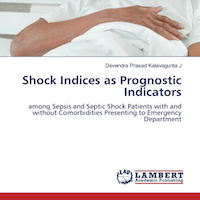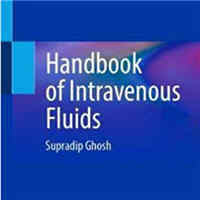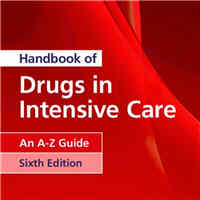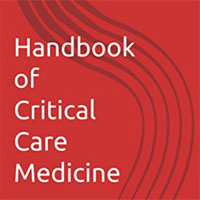Tag: prognosis
Severe Adenoviral Infections: Disease Progression and Poor Prognostic Markers
Low hemoglobin, high serum ferritin, and high LDH in the second week are markers of disease progression and poor prognostic markers in severe adenoviral infections, emphasizing further research and targeted interventions. The... read more
Increased Sodium Levels Associated with Ceftriaxone Administration
Serum sodium elevation is considered a frequent manifestation in critically ill patients, with significant clinical outcomes and requiring timely management. This case report suggests a possible association between the... read more
Promising Prognostic Predictors in Sepsis Patients Using Lactate and Albumin Ratio
Serum Lactate/Albumin ratio and BAR ratio were significantly higher in sepsis and/or septic shock and associated with increased length of hospital stay and increased in-hospital mortality and poor clinical outcome inside... read more
NIV Effectiveness in Critical Patients with ARF and Do Not Intubate Order
The prevalence of do-not-intubate (DNI) order was frequent in patients with acute respiratory failure (ARF) admitted to the ICU, being related to age, comorbidity, frailty and the underlying disease. non-invasive ventilation... read more
Lactate Trajectory Models for Predicting AKI and Mortality in Hyperlactatemia Patients
The present study underscores the significant prognostic value of lactate trajectories in critically ill patients, particularly those with hyperlactatemia. Our findings suggest that rapid lactate clearance is strongly... read more
Clinical Prediction Model Development for Stages of AKI in Critically Ill Patients
Using readily available predictors in the ICU setting, we could develop a prediction model for different stages of AKI with good performance and promising clinical usefulness. Among critically ill patients, acute kidney... read more
Prognostic Predictor Using Lactate-to-Albumin Ratio in Patients with Cirrhosis and Sepsis
Lactate-to-albumin ratio (LAR) is strongly associated with poor prognosis in patients with cirrhosis and sepsis. LAR is a promising prognostic marker that provides clinicians with a simple and effective tool for risk... read more
Prognostic Accuracy of POCUS in Patients with Pulseless Electrical Activity
This systematic review and meta-analysis shows that among 1,202 patients across 18 studies, point-of-care ultrasound (POCUS) exhibits high prognostic accuracy for survival to admission (SHA) and moderate accuracy for ROSC... read more
Asthma Course Evaluation in PICU Due to Severe Asthma Exacerbation
Admission to the PICU due to severe asthma exacerbation not only increases the risk of recurrent asthma exacerbations but also serves as a risk factor for stepping up maintenance treatment according to GINA guidelines during... read more
Central vs. Peripheral VA-ECMO Cannulation on Postoperative Graft Dysfunction in Lung Transplantation
Lung transplantation (LTx) is the definitive treatment for end-stage pulmonary diseases, with venoarterial extracorporeal membrane oxygenation (VA-ECMO) used as a common perioperative support. However, it remains unclear... read more
Cumulative Fluid Balance During the First Three ICU Days in Septic Patients with Heart Failure
In septic patients with HFpEF, positive fluid balance of CFB-day1 might improve the prognosis of patients. However, from the second day, fluid overload was associated with poor prognosis. Therefore, we propose that on... read more
Prognostic Value of Composite Inflammatory Markers in COPD Patients
Elevated systemic immune inflammation index (SII), systemic inflammatory response index (SIRI), pan-immune inflammation value (PIV), neutrophil-to-lymphocyte ratio (NLR), and platelet-to-lymphocyte ratio (PLR) are associated... read more
Shock Indices as Prognostic Indicators: among Sepsis and Septic Shock Patients with and without Comorbidities Presenting to Emergency Department
Almost 30 million people are affected, and 3 million deaths happen every year because of sepsis. According to WHO's (World Health Organization) Global Report on Epidemiology and Burden of Sepsis report 2020, half of the... read more

Effect on Norepinephrine Administration Timing on Prognosis of Septic Shock Patients
Norepinephrine initiation ≤1 h is associated with lower 28-day mortality in patients with septic shock. Early norepinephrine administration is also associated with a shorter time to achieve MAP ≥65 mmHg, lower 24-h intravenous... read more
Lymphocyte Count Trajectories Associated with Prognosis of Sepsis Patients
Three distinct lymphocyte trajectories were identified in sepsis patients using GBTM. Trajectory 3 was a strong predictor of 7-day and 28-day mortality, while Trajectory 1 was associated with early death. These findings... read more
Mitral Valve Transcatheter Edge-to-Edge Repair (MV-TEER) in Patients with Secondary Mitral Regurgitation Improves Hemodynamics, Enhances Renal Function, and Optimizes Quality of Life in Patients with Advanced Renal Insufficiency
Secondary mitral regurgitation (MR) is a common valvular heart disease burdening the prognosis of patients with co-existing chronic heart failure. Transcatheter edge-to-edge mitral valve repair (MV-TEER) is a minimally... read more
Predictive Value of Combined Detection of Serum LGALS3BP and GDF-15 for the Prognosis of ICU Sepsis Patients
Serum LGALS3BP and GDF-15 levels are abnormally elevated in the death group of ICU sepsis patients, suggesting potential application value as prognostic markers for sepsis. The combined use of LGALS3BP and GDF-15 can... read more
Association Between Comorbid COPD and Prognosis of Patients Admitted to ICU for Non-COPD Reasons
Comorbid COPD increased the risk of 28-day mortality among patients admitted to the ICU for non-COPD reasons, especially for those admitted to the cardiac surgery recovery unit. A retrospective cohort study was performed... read more
BPRI and Clinical Outcomes in Patients with Septic Shock
Use of the novel dose-effect index, Blood Pressure Response Index (BPRI) was proposed to allow rapid bedside assessment of the reactivity of septic shock patients to vasoactive drugs, as isolated MAP or VIS cannot reflect... read more
EEG Patterns for Predicting Poor Outcome After Cardiac Arrest
The specificity of the ERC-ESICM-recommended EEG patterns for predicting poor outcome after cardiac arrest exceeds 90% but is lower than in previous studies, suggesting that large-scale implementation may reduce their accuracy.... read more
Using Deep Neural Networks for Survival Prediction in VA-ECMO
Venoarterial extracorporeal membrane oxygenation (VA-ECMO) is a complex and high-risk life support modality used in severe cardiorespiratory failure. ECMO survival scores are used clinically for patient prognostication... read more
The Contribution of Procalcitonin, C-Reactive Protein and Interleukin-6 in the Diagnosis and Prognosis of Surgical Sepsis
The mortality rate was quite high in our study, consistent with the elevated serum biomarker concentrations, which were higher in non-survivors compared with survivors. C-reactive protein (CRP) and IL-6 were the most effective... read more









